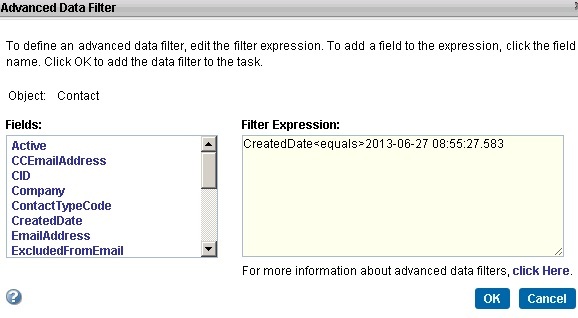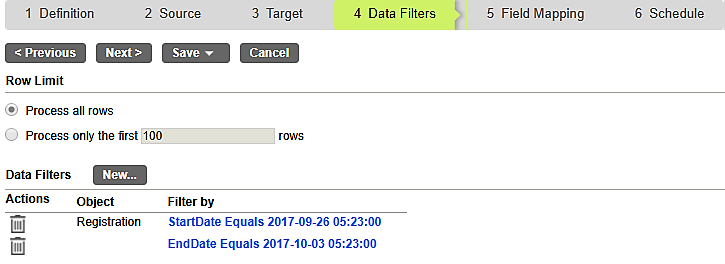Data Filters
You can use data filters to fetch specific data of a particular object. The Data Synchronization task processes the data based on the filter field assigned to the object.
Note: The Cvent Connector supports $LastRunTime parameter and all the filter fields supported by Cvent.
Perform the following steps to filter data:
1. Select Data Filters tab in a Data Synchronization task.
The Data Filters tab appears.
2. Click New.
The Data Filter dialog box appears.
3. Specify the following details:
Field Type | Description |
|---|
Object | Select Object for which you want to assign filter fields. |
Filter By | Select the Filter Field. |
Operator | Select the operator. |
Filter Value | Enter the Filter value. |
4. Click OK.
Note: You can view the records modified in the past 10 hours in the Data Preview tab. To view records for all the objects, you must use the LastModifieddate field. To view records for Events, you must use the EventLauchDate field.
Filter Fields
The following table the fields that you can use to filter Cvent objects:
Object | Fiter Field | Data Type | Supported Operators | Values Allowed |
|---|
Contact* Contact_ContactGroupDetail Contact_DistributionListDetail | id | String | F1* | Any string value |
SourceId | String | F1* | Any string value |
FirstName | String | F1* | Any string value |
LastName | String | F1* | Any string value |
EmailAddress | String | F1* | Any string value |
CCEmailAddress | String | F1* | Any string value |
Company | String | F1* | Any string value |
ContactTypeCode | String | F1* | Any string value |
Active | Boolean | Equals | 1/0 |
ExcludedFromEmail | Boolean | Equals | 1/0 |
LastOptOutDate | DateTime | F2* | Any Date Time value |
LastModifiedDate | DateTime | F2* | Any Date Time value |
CreatedDate | DateTime | F2* | Any Date Time value |
HomeStateCode | String | F1* | Any string value |
LeadSource | String | F1* | Any string value |
WorkStateCode | String | F1* | Any string value |
SearchType* | String | F1* | AND/OR |
Event Event_ProductDetail, Event_DocumentDetail, Event_TargetListDetail, Event_WeblinkDetail | Id | String | F1* | Any string value |
EventCode | String | F1* | Any string value |
EventTitle | String | F1* | Any Date Time value |
EventStartDate | DateTime | F2* | Any Date Time value |
EventEndDate | DateTime | F2* | Any Date Time value |
EventLaunchDate | DateTime | F2* | Any Date Time value |
EventStatus | String | F1* | Any string value |
PlanningStatus | String | F1* | Any string value |
Hidden | Boolean | Equals | 1/0 |
Location | String | F1* | Any string value |
StateCode | String | F1* | Any string value |
LastModifiedDate | DateTime | F2* | Any Date Time value |
SearchType* | String | F1* | AND/OR |
Invitee Invitee_InternalInfoDetail, Invitee_RegretSurveyDetail, Invitee_WeblinkDetail, | ContactId | String | F1* | Any string value |
SourceId | String | F1* | Any Date Time value |
FirstName | String | F1* | Any Date Time value |
Last name | String | F1* | Any string value |
Id | String | F1* | Any string value |
EmailAddress | String | F1* | Any string value |
Participant | String | F1* | 1/0 |
EventId | String | F1* | Any string value |
Status | String | F1* | Any string value |
SearchType* | String | F1* | AND/OR |
Registration Registration_GuestDetail, Registration_OrderDetail, Registration_PaymentDetail, Registration_EventSurveyDetail | Id | String | F1* | Any string value |
Status | String | F1* | Any string value |
ContactId | String | F1* | Any string value |
InviteeId | String | F1* | Any string value |
SourceId | String | F1* | Any string value |
FirstName | String | F1* | Any string value |
LastName | String | F1* | Any string value |
EmailAddress | String | F1* | Any string value |
EventId | String | F1* | Any string value |
RegistrationDate | DateTime | F2* | Any Date Time value |
CancelledDate | DateTime | F2* | Any Date Time value |
LastModifiedDate | DateTime | F2* | Any Date Time value |
ConfirmationNumber | String | F1* | Any string value |
RegistrationType | String | F1* | Any string value |
SearchType* | String | F1* | AND/OR |
Response Response_SurveyDetail | Id | String | F1* | Any string value |
ContactId | String | F1* | Any string value |
SurveyId | String | F1* | Any string value |
Status | String | F1* | Any string value |
CompletionDate | DateTime | F2* | Any Date Time value |
LastModifiedDate | DateTime | F2* | Any Date Time value |
SearchType | String | F1* | Any string value |
Survey Survey_WeblinkDetail | SurveyCode | String | F1* | Any string value |
SurveyTitle | String | F1* | Any string value |
EventLaunchDate | DateTime | F2* | Any Date Time value |
EventCloseDate | DateTime | F2* | Any Date Time value |
SurveyStatus | DateTime | F2* | Any Date Time value |
SearchType | String | F1* | Any string value |
Transaction Transaction_DistributionDetail | ContactId | String | F1* | Any string value |
InviteeId | String | F1* | Any string value |
EventId | String | F1* | Any string value |
Success | Boolean | Equals | 1/0 |
TransactionType | String | F1* | Any string value |
TransactionNumber | String | F1* | Any string value |
PaymentType | String | F1* | Any string value |
NameOnCard | String | F1* | Any string value |
ReferenceNumber | String | F1* | Any string value |
BatchNumber | String | F1* | Any string value |
Amount | String | F1* | Any string value |
TransactionDate | DateTime | F2* | Any Date Time value |
LastModifiedDate | DateTime | F2* | Any Date Time value |
SearchType | String | F1* | Any string value |
F1* - Supports Equals, Not Equals, Starts With, and Contains operators.
F2* - Supports Equals, Not Equals, Less than, Less than or Equals, Greater, and Greater than or Equals operators.
SearchType* - Supports only AND and OR values as input parameter.
Note: You can use StartDate and EndDate filter fields to filter parent objects.
Advanced Filters
To run search queries containing complex filter expressions, use advanced data filter. Cvent advanced filter supports AND conditional operator and some logical operators.
Note: You can determine whether a field is filterable after running the Data Synchronization task.
1. Click Advanced in Data Filter dialog box.
The Advanced Data Filter dialog box appears.
2. Enter the Filter Expression.
3. Click OK.
The following image shows the Advanced Data Filter page:
The following is the syntax format for Filter Expression:
Field1<Operator1>Value1;Field2<Operator2>Value2
The following are the significance of the terms:
- - Field1 and Field2 are Cvent fields.
- - Operator1 and Operator2 are operators supported for filter expression.
- - Value1 and Value 2 are corresponding values.
Cvent supports the following logical operators:
Operator | Symbol |
|---|
equals | = |
notEquals | != |
lessThan | < |
lessOrEquals | <= |
greaterThan | > |
greaterOrEquals | >= |
contains | %<value>% |
DoesNotContain | %<value> |
startsWith | <value>% |
includes | includes |
Note: You can apply multiple filters at one instance.
For example, C_EmailAddress=’gsavloff@12ed.gba.gov.ar’AND C_FirstName=’Gabriel’
You can fetch the data using advanced filter search by giving the value in yyyy-MM-dd HH:mm:ss.SSS (Year-Month-day Hour:Minutes:Seconds:milliseconds) format.
You can use StartDate and EndDate filter fields to configure advanced filters.
Note: The search in advanced filter functions similar to the search functionality supported by Cvent application.
Delta Records
You can use the Cvent Connector to fetch data records that has changed over a time period for a Cvent object.
The Data Synchronization task fetches the data that has changed for the period that you specify in the StartDate and EndDate filter fields.
When retrieving delta records, the Secure Agent performs the following tasks:
- •Reads data that was created within the specified time period and marks them for insert.
- •Reads data that was updated within the specified time period and marks them for update.
- •Reads data that was deleted within the specified time period and marks them for delete
Retrieving Delta Records
You can use data filters to fetch data records that fetch data records that has changed over a time period for a Cvent object. The Data Synchronization task fetches the data that has changed for the period that you specify in the StartDate and EndDate filter fields.
Perform the following steps to fetch delta records:
1. Select Data Filters tab in a Data Synchronization task.
The Data Filters tab appears.
2. Click New.
The Data Filter dialog box appears.
3. Specify the following details to create a data filter using StartDate filter field:
Field Type | Description |
|---|
Object | Select the object on which you want to apply data filter. |
Filter By | Select the StartDate filter field. |
Operator | Select the Equals operator. |
Filter Value | Enter the filter value in GMT time zone. |
4. Click OK.
5. Repeat the steps 1 to 2 and specify the following details to create a data filter using EndDate filter field:
Field Type | Description |
|---|
Object | Select the object on which you want to apply data filter. |
Filter By | Select the EndDate filter field. |
Operator | Select the Equals operator. |
Filter Value | Enter the filter value in GMT time zone. |
6. Click OK.
The following image shows the data filters applied on the Registration object:
When you run the Data Synchronization task, the Secure Agent fetches all the records that were inserted or updated between the StartDate and EndDate that you specified in the Data Filters tab.
Rules and Guidelines for Data Filters
Consider the following rules and guidelines when you apply data filters on a Cvent object:
- •You must specify the value of StartDate and EndDate filter fields in GMT time zone.
- •The Cvent Web Service ignores the seconds in the datetime value specified in the filter field.
For example, 12.30.15 is applied as 12.30.00.
- •If you want to use UTC time zone, set the UTC Time Zone field in the connection properties to the time zone of the Cvent server.
If you do not specify the UTC Time Zone property and specify a datetime value for a filter field, you must specify the value of the filter field in the time zone of the Cvent server
- •If you specify a datetime value for a filter field and set the UTC Time Zone property to the time zone of the Cvent server, you must specify the value of the filter field in GMT time zone.
For example, you must specify the value of $LastRuntime filter field in GMT time zone.
- •If you use the StartDate and EndDate filter fields and set the UTC Time Zone property to the time zone of Cvent server, you must specify the value of the filter field in GMT time zone. The value of UTC Time Zone property is ignored.
- •If you have used StartDate and EndDate filter fields in an existing task, you must refresh the existing Data Synchronization task.




